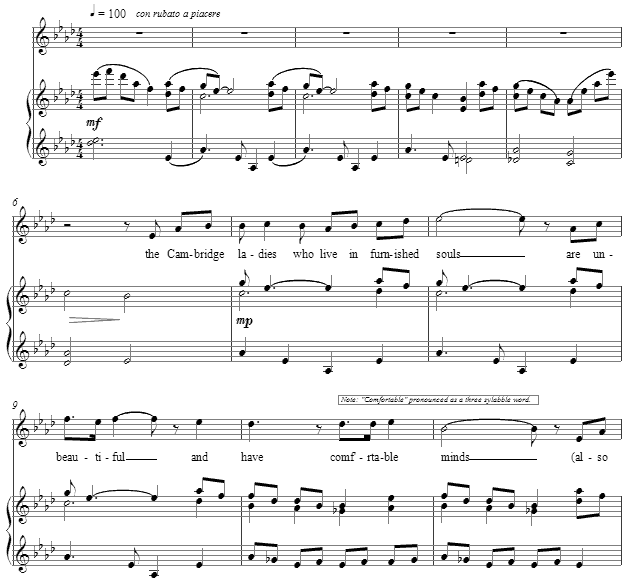Music and Texts of GARY BACHLUND Vocal Music | Piano | Organ | Chamber Music | Orchestral | Articles and Commentary | Poems and Stories | Miscellany | FAQs |
the Cambridge ladies - (1983)
E. E. Cummings
for medium voice and piano
The Cambridge ladies who live in furnished souls
are unbeautiful and have comfortable minds
(also, with the church's protestant blessings
daughters,unscented shapeless ....
(for the remainder of this text, please consult any one of the many printed and electronic sources)
[ circa 2' 10" ]
"the Cambridge ladies who live in furnished souls" was originally published in Broom (May 1922),
and subsequently republished in SONNETS-- REALITIES, I, Tulips and Chimneys (1923)
E. E. Cummings
The "unbeautiful" Cambridge ladies "coyly bandy scandal of Mrs. N and Professor D." Though Cummings pronounces them unbeautiful, they must think themselves to be quite beautiful, as their "cornerless" "box of sky lavender" shelters them from the ravages of a real and harsh world, as Cummings see it and their part in it most skeptically.
These women are among the breed of sedate social activist who will engage in a passion as long as it remains at a discrete and safe distance, and whose busy fingers are "delighted" when busy at such passionless passions. [ 1 ]
Therefore I thought the song setting must be itself sweet, a "lavender" counterpoint to the sense of Cummings' social complaint. [ 2 ]
The setting begins in a pleasant rocking gesture, to indicate these ladies and their seeming comfort. As their gossip comes to be revealed, there comes a polytonal dissonance in which competing "comforts" gently clash, rhythmically as in terms of tonal regions. I specifically notate an "American" pronunciation of some of the polysyllabic words which the singer is asked to observe.
The score for the Cambridge ladies according to the text published in 1922 [ 3 ] is available as a free PDF download, though any major commercial performance or recording of the work is prohibited without prior arrangement with the composer. Click on the graphic below for this piano-vocal score.
NOTES
[ 1 ] I comment on that "sedate social activist" of which Cummings writes. Though Cummings' poem was written in the 1920s, the characterization remains consistently apt today. Phyllis Chesler writes, "To my horror, most western academic and mainstream feminists have not focused on what I call gender apartheid in the Islamic world or on its steady penetration of Europe. Such feminists have also failed to adequately wrestle with the complex realities of freedom, tyranny, patriotism, self-defense, and the concept of a just war." [ The Death of Feminism, 2005, Palgrave Macmillan, New York. p. 2 ]
The modern enthusiasm for relativism and multiculturalism has, Chesler argues, blinded many modern feminists in the same way as Cummings observed, "at the present writing one still finds / delighted fingers knitting for the is it Poles? /perhaps." The question Cummings posed ninety years before Chesler is the same question. What is truly relevant? What stance is one taking? What action is one taking? Cummings suggests that "the Cambridge ladies do not care," and it seems many modern "caring" social activists miss the global picture for their insistence on fitting in to their social strata, whether it be academic, political, or religious.
[ 2 ] Cummings was, of course, a distinctly American poet whose art was novel in its time, and novel today as well. His modernity had its critics, such that many large publishers rejected publication of his works, until the body of work and tenacity of his art created for that work a base of readers which was finally recognized by mainstream publishers. Today, though not in his early career, Cummings is recognized as a significant artist.
The artist as social activist is one who speaks out in some convincing way, and often political opinion is rejected in its time, to be recognized at a later date as the more sensible and accepted view. (The inverse is equally true, wherein an accepted "art" is later seen as less authentic or original.) One only need think of the so-called "degenerative art" as deemed by the National Socialists, or of Soviet Socialist Realism which sought to censor other forms of opinion and expression. One might also think of the "accepted" artists at the center of the Parisian circle in the time of Toulouse-Lautrec's death, wherein these now far lesser names sought to censor, repress and even destroy the body of work created by Toulouse-Lautrec.
If Cummings' metaphorical "moon rattles like a fragment of angry candy" somewhere in the world, such as gender or racial apartheid, Cummings informs us that so many "caring" people do not truly care, as long as their world, belief systems and "comfortable minds" are neither challenged nor upset by real and pressing issues.
[ 3 ] Broom published monthly from November 1921 to January 1924 with a circulation of about 4,000 by 1923. Sold at 50 cents a copy or in subscription for 5 dollars a year, Broom was “heavy of weight, rich in color, fine in binding and printing…nothing quite like its aristocratic format had ever been seen in America.” It began as a business enterprise in Rome, and the editor and publisher moved some of its short-lived work to Berlin and thence to New York. It failed in 1924. The magazine also reproduced paintings by artists such as Picasso and helped to establish the literary careers of young, unconventional American writers. Broom is not known for being a pioneering little magazine, but its “importance lies in the fact that it was in the vanguard of an intellectual movement, in the fact that it helped win the fight against the sentimentalities of the genteel tradition.”

